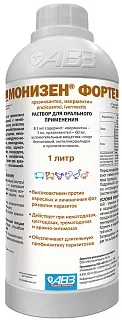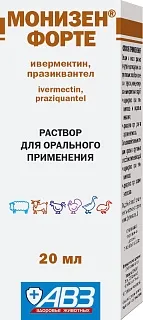Advantages
- Highly active against adult and larval phases of parasite development
- Valid for nematodosis, cestodosis, the trematode and arachno Enomoto
- Provides long-term prevention of parasitosis
Composition and pharmacological properties
Monisen forte oral contains in 1 ml as active substances ivermectin-5 mg and praziquantel-60 mg, and as auxiliary substances: benzyl alcohol, methylpyrrolidone and propylene glycol.
In appearance, the drug is a transparent liquid from colorless to pink.
Monisen forte oral belongs to the group of combined antiparasitic drugs.
Included in the Monisen forte oral praziquantel and ivermectin provide a wide range of antiparasitic action of the drug. MONIZ Forte active against imaginal and larval phases of development of nematodes of the gastro-intestinal tract and lungs, cestodes, trematodes, the larvae of gadflies, sarcopoenia, gamasoidea and ticks, Krovostok, maliah (vlasiadou, of lice peredov) mammals and birds.
Ivermectin is a synthetic derivative of avermectin, the producer of which is actinomycete Streptomyces avermitilis, belongs to the group of macrocyclic lactones. The mechanism of action of ivermectin is its effect on the penetration of chlorine ions through the membranes of nerve and muscle cells of ecto - and endoparasites. The main targets are glutamate-sensitive chlorine channels, as well as gamma-aminobutyric acid receptors. Changing the process of penetration of chlorine ions disrupts the impulses, which leads to paralysis and death of the parasite.
Praziquantel is a synthetic derivative of pyrazinoisoquinoline. The mechanism of action of praziquantel is based on depolarization of neuromuscular ganglioblockers, violation of glucose transport and microtubular function of cestodes, which causes violation of muscle innervation, paralysis and death of helminths.
After parenteral and oral administration of the drug praziquantel and ivermectin are well absorbed, enter the systemic circulation and are distributed in the organs and tissues of animals and poultry, providing long-term antiparasitic effect.
Indications for use.
Monisen forte oral is used for prophylactic and therapeutic purposes for large and small cattle, deer and farm birds to tsestodozah, nematodes of the lungs and gastrointestinal tract, trematode, Estrosi, the common scab of chorioptes, the sarcoptic mange, Ixodidae, sipunculans, melophagus, bouikhalene, the hypodermatosis, as well as arachno Enomoto poultry.
Contraindications.
Contraindications to use is the individual hypersensitivity of the animal to the components of the drug, including a history. Do not use MONIZEN Forte laying hens, eggs which are used for food purposes, repair young chickens less than 2 weeks before the start of egg laying, due to the accumulation of the drug in the eggs, as well as exhausted, sick with infectious diseases and recovering animals.
Do not use Monisen forte oral for dairy and pregnant animals less than 28 days before birth, in connection with the release of the drug with milk.
Doses and order of application.
Monisen forte oral for oral administration is administered to sheep and goats orally (by mouth) individually or by group method in a mixture of grain and concentrated feed or water once with worms and obodovich infestations, and twice in other arachno Enomoto, agricultural birds orally group with drinking water, once with worms and twice at arachno Enomoto.|
Type of animal |
The route of administration, dose MONIZ Forte ml / kg animal weight |
|
Cattle, deer |
Intramuscularly
At nematodes-1 ml/20 kg
At trematodoses-1 ml/15 kg
At cestodoses-1 ml/20 kg
At arachno-entomoses-1 ml/20 kg |
|
Sheep |
Subcutaneously, orally
At nematodes-1 ml/20 kg
At trematodoses-1 ml/15 kg
At cestodoses-1 ml/20 kg
At arachno-entomoses-1 ml/20 kg |
|
Goats |
Subcutaneously, orally
At nematodes-1 ml/15kg
At trematodoses-1 ml/15 kg
At cestodoses-1 ml/15 kg
At arachno-entomoses-1 ml/20 kg |
|
Agricultural poultry (broiler chickens, young chickens, turkeys, geese, ducks) |
Orally
At nematodes-1 ml/20 kg
At trematodoses-1 ml/20 kg
At cestodoses-1 ml /20 kg
At arachno-entomoses-1 ml/20 kg |
- cattle, sheep, deer with nematodosis of the gastrointestinal tract (hemonchosis, bunostomosis, esophagostomosis, nematodirosis, habertiosis, cooperiosis, ostertagiosis, strongyloidosis, trichostrongylosis, trichocephalosis, neoascaridosis) - 1 ml per 20 kg of animal weight;
– large and small ruminants, the reindeer and the nematodes in the lungs (dictyocaulus, Mullerian, cystocoele, protostrongylidoses) and cestodosis (monition, vitellinus, titanites) – 1 ml per 20 kg of animal weight;
- cattle, deer, sheep with trematodosis (fascioliasis, dicroceliosis) - 1 ml per 15 kg of animal weight;
– goats with nematodosis (hemohes, bunostomum, esophagoscopes, nematodirus, chabertia, cooperia, Ostertagia, strongyloidiasis, Trichostrongylus, trihozefalez, neoascaris), cestodosis (monition, vitellinus), the trematode (fascioliasis, dicrocoeliosis) – 1 ml per 15 kg of animal weight;
– sheep in estrosa once, individually, subcutaneously– 1 ml per 20 kg of animal weight or the group – 1 ml per 20 kg of body weight mixed with half norm of a single grain or concentrated feed from bird feeders to ensure free access of animals;
- cattle with hypodermatosis once, individually intramuscularly-1 ml per 20 kg of animal weight
- cattle, small cattle, deer with psoroptosis, sarcoptosis, chorioptosis, melophagosis, bovikolese treatment is carried out twice (2 times) with an interval of 10-14 days, with ixodidosis-once, at a dose of 1 ml per 20 kg of animal weight;
– for broiler chickens, for chickens, turkeys, geese and ducks for nematodes (amidostomosis, gangularis, ascarides, heterakis, singamas, tomingas, capillaries), cestodosis (drepanidinae, gimenolepidoz, raillietina, gavenis) and trematode (prosthogonimus, echinostomatidae) at a dose of 1 ml per 20 kg body weight once by group method with water; to combat entomoses caused by fluff eaters (Aphaniptera spp., Menacanthus stramineus, Ceratophyllus gallinae, Menopon gallinae), acaroses caused by Dermanyssus gallinae, Knemidocoptes mutans, Dermatoryktes mutans-treatment is carried out twice (2 times) at intervals of 10-14 days at the specified dose.
In the oral method of application with water for drinking, the calculated necessary dose of the drug is preliminarily diluted in a small amount of warm (25-30°C) water.
To ensure uniform distribution of the drug for oral use, it is introduced into feed or water with careful stirring, using step mixing.
Before each binge use freshly prepared solution of the drug.
Birds after deworming within 2-3 hours do not feed and do not allow to reservoirs, watering is not limited.
Group method of application of the preparation and cooking procedure carolecarson mixture Monisen forte oral for sheep
1) determine the total mass of the group of sheep;
2) determine the amount of Monizen Forte per group of sheep based on the indications for use and the dose of 1 ml per 15 kg or 1 ml per 20 kg of animal weight;
3) determine a single grain weight per group of sheep based on the norm 200-300 g per head-200-300 g × the number of heads;
4) determine the volume of water for the preparation of the working solution Monizen Forte - ½ of the grain weight;
5) prepare Monizen Forte working solution-mix the measured volume of Monizen Forte (see item 2) with the measured volume of water (see item 4);
6) prepare the mixture food-drug - pour a measured amount of grain (see item 3) in a container, add the working solution (see item 5) in a ratio of 2: 1, mix thoroughly, leave until fully absorbed grain working solution, then sprinkle the mixture with a thin layer to dry;
7) evenly pour the resulting mixture food-drug in feeders, providing free access to all the sheep of the group and let the sheep.
Side effects.
When applying Monisen forte oral in accordance with this instruction side effects and complications are usually not observed. In farm birds may be a small short-term excitement immediately after taking the drug, which spontaneously passes after the departure of helminths. With increased sensitivity of the animal to the components of the drug and the appearance of allergic reactions, the use of the drug is discontinued and antihistamines and symptomatic therapy are prescribed.
Waiting period.
Slaughter for meat of cattle, small cattle and deer is allowed not earlier than 35 days, geese and ducks not earlier than 20 days, chickens and turkeys not earlier than 15 days after the last application of Monisen forte oral . In the case of forced slaughter of animals and farm birds before the deadline, the meat can be used as fodder for fur-bearing animals.
Storage.
Store the drug in the closed packaging of the manufacturer, in a place protected from direct sunlight, separately from food and feed at a temperature of 2 °C to 30 °C.

The information provided in this catalog is for reference only. There may be some changes in the characteristics, packaging and packaging of products.
AVZ reserves the right to make such changes without notice. You can get full information about the updated products from your personal manager or your nearest AVZ dealer.
All drugs for veterinary use from this catalog may be contraindicated and when using it is necessary to familiarize yourself with the Instructions for Use.

















